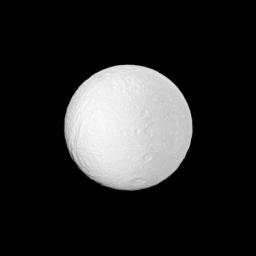
|
Up and Down Tethys
- Click the image above for a larger view
- Full-Res JPEG (705 x 705) (17.9 kB)
- Full-Res TIFF (705 x 705) (497.8 kB)
Caption:
The Cassini spacecraft profiles several features oriented north-south on Saturn's moon Tethys.
A line of craters runs north to south near the center of the image: (from top) Phemius, Polyphemus, Ajax and the large southern crater Antinous. Ithaca Chasma, which slices across more than 1,000 kilometers (620 miles) of the moon's icy surface, can be seen running roughly north to south on the left of the image. See PIA07734 for a closer view of Ithaca Chasma.
This view looks toward the area between the trailing hemisphere and Saturn-facing side of Tethys (1,062 kilometers, or 660 miles across). North on Tethys is up and rotated 1 degree to the left.
The image was taken in visible light with the Cassini spacecraft narrow-angle camera on March 3, 2010. The view was acquired at a distance of approximately 506,000 kilometers (314,000 miles) from Tethys and at a Sun-Tethys-spacecraft, or phase, angle of 5 degrees. Image scale is 3 kilometers (2 miles) per pixel.
Background Info:
The Cassini-Huygens mission is a cooperative project of NASA, the European Space Agency and the Italian Space Agency. The Jet Propulsion Laboratory, a division of the California Institute of Technology in Pasadena, manages the mission for NASA's Science Mission Directorate, Washington, D.C. The Cassini orbiter and its two onboard cameras were designed, developed and assembled at JPL. The imaging operations center is based at the Space Science Institute in Boulder, Colo.
For more information about the Cassini-Huygens mission visit http://saturn.jpl.nasa.gov . The Cassini imaging team homepage is at http://ciclops.org .
Cataloging Keywords:
| Name | Value | Additional Values |
|---|---|---|
| Target | Tethys | Saturn |
| System | Saturn | |
| Target Type | Satellite | Planet |
| Mission | Cassini-Huygens | |
| Instrument Host | Cassini Orbiter | |
| Host Type | Orbiter | |
| Instrument | Imaging Science Subsystem (ISS) | |
| Detector | Narrow Angle Camera | |
| Extra Keywords | Crater, Grayscale, Rotation, Visual | |
| Acquisition Date | ||
| Release Date | 2010-04-14 | |
| Date in Caption | 2010-03-03 | |
| Image Credit | NASA/JPL/Space Science Institute | |
| Source | photojournal.jpl.nasa.gov/catalog/PIA12611 | |
| Identifier | PIA12611 | |
